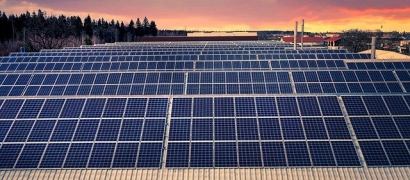
Humans have harnessed the power of sunlight since the time of the Greeks when mirrors were used to concentrate sunlight to light torches. But it wasn’t until 1954 that photovoltaic (PV) technology was developed at Bell Labs. Traditional PV cells are a sandwich of a positive and negative layer of silicon. When solar energy hits the layers, it causes electrons to pass between them, generating electricity. While the earliest cells could claim only a 4% efficiency, the efficiency of PV cells since that time has increased to approximately 15-20 percent.
Boudjouk, a Jordan A. Engberg distinguished professor and Chamber of Commerce distinguished professor, has researched the synthesis of compounds containing silicon for nearly five decades. His work has developed materials that are semiconducting, can be used as inks for printed electronics applications and for novel photovoltaic devices. He has created unique materials such as the liquid precursor cyclohexasilane, which is currently being used in the creation of nontoxic silicon quantum dots that are tiny nanometer semiconductors that emit light when their electrons are exposed to UV light and hold great promise in medicine.
Boudjouk is once again paving new ground with this research. He hopes to create solar PV cells that will generate electricity from low levels of light such as found during cloudy days and under water.
“We’ve got a history of solar research at NDSU,” he said. “It’s a part of our century plus experience of developing new materials and coatings.”
The main drawback of PV cells has been the requirement of strong, unfiltered sunlight to operate at peak efficiency. Boudjouk notes how the U.S. Navy is interested in obtaining energy from the sun, but they know that their operations don’t always occur during the day or in perfect conditions, and, especially in the case of rescue operations, you can’t have someone’s life depending upon ideal weather.
Creating electricity from the sun is cheap energy because there are no moving parts and the researchers are hoping to make it even more efficient by making it viable all the time, even at night.
Boudjouk adds, “Could we even capture energy from moonlight? Perhaps. We’d have to call it ‘lunar energy’ instead of solar energy!”
So Boudjouk is once again tasked with creating a brand-new material with brand-new properties to address a need. “This is a high level of discovery. It’s always risky when you’re creating new materials, but there are great rewards if you’re successful.”
Like the results of other research endeavors that begin with the military, Boudjouk points out the impact his work may have on private industry. He says he looks for a sweet spot where the needs of military are met and there’s a reasonable opportunity for commercialization afterwards. This is a model he’s followed many times during his career at NDSU.
“I keep an eye on what industry is doing to know their needs,” he said. “Few companies, especially small ones, can afford to do this type of basic research, but they are very interested in it because they are trying to solve exactly the same problems.”
In order to succeed, Boudjouk has mapped out a two-year plan for the research that will require setting up specialized equipment for the research and training researchers how to use it. This equipment will help in the creation of what he calls complex mixtures, or extremely precise and pure combinations of elements. The research will utilize robotic processes to conduct dozens of experimental mixtures at once that will then be measured for purity down to the level of specific atoms.
Boudjouk has begun building a staff of post-docs and undergraduate students who will work with him in his lab. The lab space will be housed in the NDSU R2 building. The facility boasts both Class 100 and Class 10,000 bays encompassing a total area under filtration of 12,000 square feet.
“R2 is such a great facility and it’s perfect for this kind of work given the electronics capabilities of the cleanrooms and the efficient design of the chemistry labs.” he said.
Funding for the project was secured through North Dakota Senator John Hoeven.
“This award builds on Dr. Boudjouk’s extensive work at NDSU and will provide important benefits to strengthen the capabilities of our military assets and enhance our nation’s ability to defend ourselves and our allies,” said Senator Hoeven. “By developing more efficient solar cells, UAS and other assets will be able to operate for longer and in more environments. Further, this research has the potential to significantly reduce the cost of producing these materials, helping taxpayer dollars go further.”
The U.S. Navy is providing expertise and equipment to the project from the Naval Research Lab (NRL) in Washington D.C. Boudjouk notes that this level of assistance is new for him. “We have access to equipment we don’t have at NDSU as well as to PhD-level NRL engineers, physicists and chemists who are already conducting key experiments in collaboration with us.”
"Research such as this important project led by professor Boudjouk provides significant growth to the federal portion of our research expenditures," commented NDSU vice president of research Colleen Fitzgerald, PhD. "And it robustly shows how scientific advances in energy, a key priority in the state of North Dakota, strengthens economic prosperity in the state and supports national security."
Boudjouk hopes to have some key, definitive results by summer of 2022. But he’s realistic in setting expectations given he’s tasked with creating unique never before-seen materials.
“I’m confident in the science -- the experiments aren’t that difficult.” He said, adding, “But we’ll have to wait to see if nature agrees with us.”
Information provided by NDSU

